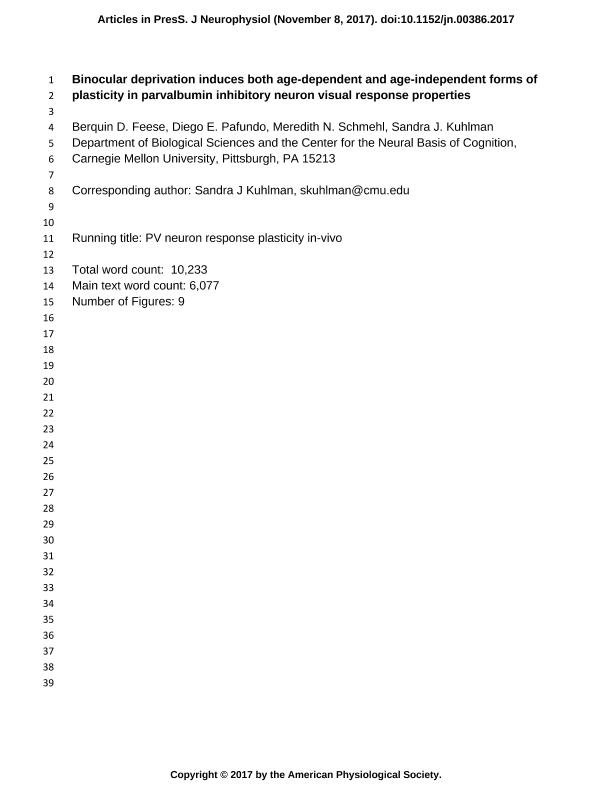Mostrar el registro sencillo del ítem
dc.contributor.author
Feese, Berquin D.
dc.contributor.author
Pafundo, Diego Esteban

dc.contributor.author
Schmehl, Meredith N.
dc.contributor.author
Kuhlman, Sandra J.

dc.date.available
2018-06-05T21:04:34Z
dc.date.issued
2018-02
dc.identifier.citation
Feese, Berquin D.; Pafundo, Diego Esteban; Schmehl, Meredith N.; Kuhlman, Sandra J.; Binocular deprivation induces both age-dependent and age-independent forms of plasticity in parvalbumin inhibitory neuron visual response properties
; American Physiological Society; Journal of Neurophysiology; 119; 2; 2-2018; 738-751
dc.identifier.issn
0022-3077
dc.identifier.uri
http://hdl.handle.net/11336/47416
dc.description.abstract
Activity of cortical inhibitory interneurons is rapidly reduced in response to monocular deprivation during the critical period for ocular dominance plasticity and in response to salient events encountered during learning. In the case of primary sensory cortex, a decrease in mean evoked firing rate of parvalbumin-positive (PV) inhibitory neurons is causally linked to a reorganization of excitatory networks following sensory perturbation. Converging evidence indicates that it is deprivation, and not an imbalance between open- and closed-eye inputs, that triggers rapid plasticity in PV neurons. However, this has not been directly tested in vivo. Using two-photon guided cell-attached recording, we examined the impact of closing both eyes for 24 h on PV neuron response properties in mouse primary visual cortex. We found that binocular deprivation induces a 30% reduction in stimulus-evoked mean firing rate and that this reduction is specific to critical period-aged mice. The number of PV neurons showing detectable tuning to orientation increased after 24 h of deprivation, and this effect was also specific to critical period-aged mice. In contrast to evoked mean firing rate and orientation tuning, measurements of trial-to-trial variability revealed that stimulus-driven decreases in variability are significantly dampened by deprivation during both the critical period and the postcritical period. These data establish that open-eye inputs are not required to drive deprivation-induced weakening of PV neuron evoked activity and that other aspects of in vivo PV neuron activity are malleable throughout life.
dc.format
application/pdf
dc.language.iso
eng
dc.publisher
American Physiological Society

dc.rights
info:eu-repo/semantics/openAccess
dc.rights.uri
https://creativecommons.org/licenses/by-nc-sa/2.5/ar/
dc.subject
Critical Period
dc.subject
Inhibition
dc.subject
Mouse
dc.subject
Parvalbumin
dc.subject.classification
Inmunología

dc.subject.classification
Medicina Básica

dc.subject.classification
CIENCIAS MÉDICAS Y DE LA SALUD

dc.title
Binocular deprivation induces both age-dependent and age-independent forms of plasticity in parvalbumin inhibitory neuron visual response properties
dc.type
info:eu-repo/semantics/article
dc.type
info:ar-repo/semantics/artículo
dc.type
info:eu-repo/semantics/publishedVersion
dc.date.updated
2018-06-05T20:14:28Z
dc.journal.volume
119
dc.journal.number
2
dc.journal.pagination
738-751
dc.journal.pais
Estados Unidos

dc.journal.ciudad
Bethesda
dc.description.fil
Fil: Feese, Berquin D.. University of Carnegie Mellon; Estados Unidos
dc.description.fil
Fil: Pafundo, Diego Esteban. University of Carnegie Mellon; Estados Unidos. Consejo Nacional de Investigaciones Científicas y Técnicas; Argentina
dc.description.fil
Fil: Schmehl, Meredith N.. University of Carnegie Mellon; Estados Unidos
dc.description.fil
Fil: Kuhlman, Sandra J.. University of Carnegie Mellon; Estados Unidos
dc.journal.title
Journal of Neurophysiology

dc.relation.alternativeid
info:eu-repo/semantics/altIdentifier/doi/https://dx.doi.org/10.1152/jn.00386.2017
dc.relation.alternativeid
info:eu-repo/semantics/altIdentifier/url/https://www.physiology.org/doi/10.1152/jn.00386.2017
Archivos asociados
